When it comes to investing, most strategies revolve around outperforming a specific benchmark, like the S&P 500. But absolute return investments take a different path. These investments aim to deliver positive returns in any market condition, whether the economy is booming, flat, or in decline. This approach makes them appealing to investors looking for consistency and less reliance on the broader market’s ups and downs.
source: Investors Trading Academy on YouTube
What Are Absolute Return Investments?
Absolute return investments focus on achieving positive returns without the need to outperform a benchmark. Instead of simply tracking the market or following the crowd, they aim to generate profit regardless of market direction. This approach contrasts with more traditional investments, where success is often defined by outperforming an index or peer group.

A core feature of absolute return strategies is their use of a wide range of techniques to achieve their goals. This might include hedging, long/short positions, arbitrage, or even derivatives. These tools allow absolute return managers to potentially profit in various market scenarios, making this type of investment valuable in both stable and volatile times.
Why Consider Absolute Return Investments?
For investors, absolute return strategies provide an appealing option for several reasons:
- Positive Performance in Any Market Condition: Unlike traditional investments that can suffer during market downturns, absolute return investments seek to achieve gains even in tough times. This makes them especially attractive during periods of economic uncertainty.
- Diversification: Absolute return strategies often have a low correlation to traditional asset classes like stocks and bonds. Adding absolute return investments to a portfolio can help reduce overall risk and enhance diversification.
- Focus on Risk Management: Many absolute return strategies prioritize risk management, seeking to limit downside exposure and deliver steadier returns over time. For those looking to protect their portfolios, this approach can be a strong defensive play.
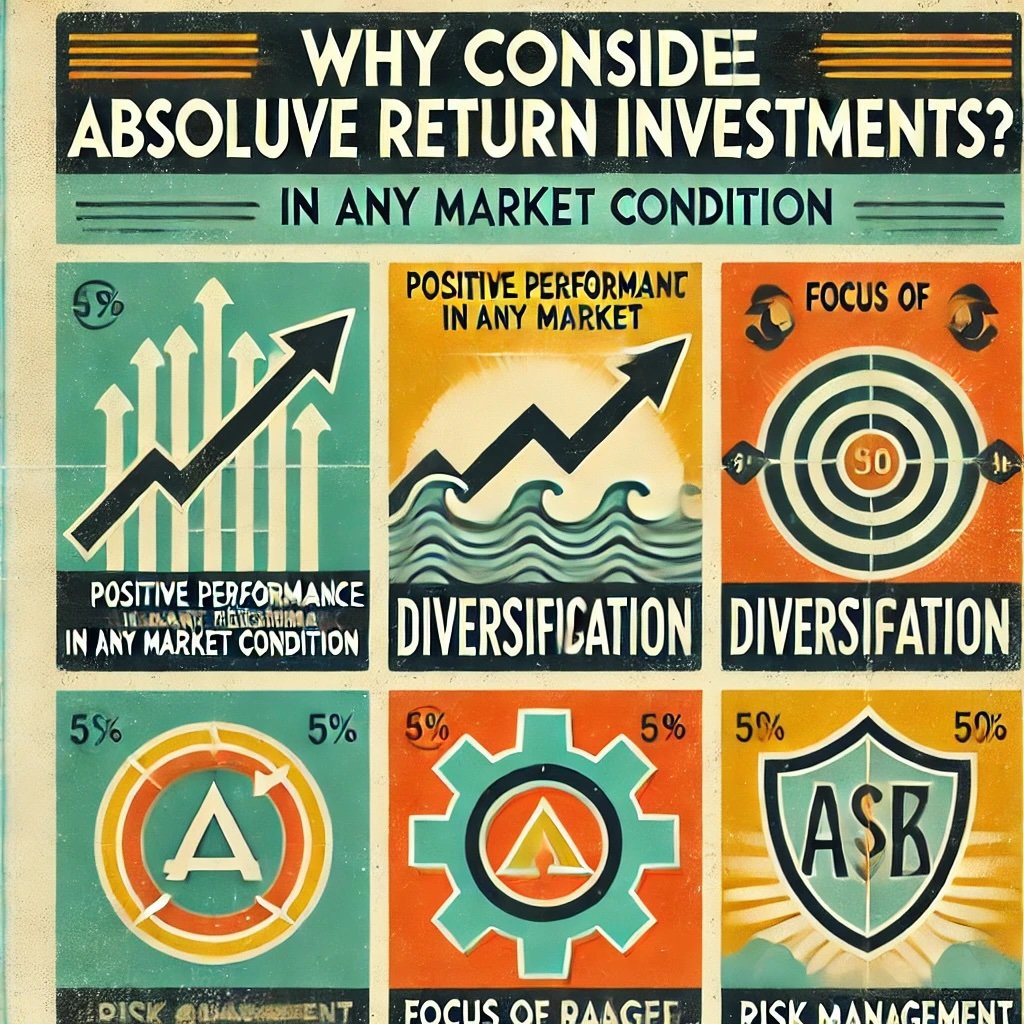
Introduction to Absolute Return Investments
We’ll explore the ins and outs of absolute return investments, giving you a complete picture of what they are, how they work, and how they might fit into a diversified portfolio. Here’s what we’ll cover:
- How Absolute Return Strategies Work: We’ll dive into the unique features and tools used by absolute return managers to deliver returns independent of market direction.
- Benefits of Absolute Return Investments: Discover the potential advantages these strategies offer, from diversification to reduced volatility.
- Risks and Drawbacks: No investment is without its challenges. We’ll look at the fees, complexity, and potential underperformance in certain market conditions.
- How to Choose Absolute Return Investments: Learn about key metrics and factors to consider when evaluating these strategies.
- Practical Applications: We’ll wrap up with a look at how absolute return investments can add stability to a portfolio.
By the end, you’ll have a solid understanding of how absolute return investments work and how they can be a valuable addition to your investment strategy, particularly if you’re looking for consistent performance across all market cycles. Whether you’re aiming for portfolio stability or seeking strategies that provide low correlation to traditional markets, absolute return investments offer tools to navigate today’s complex financial landscape.
Absolute return investing is about moving beyond the mindset of tracking benchmarks. Instead, it focuses on consistent positive performance, which can be an essential component of a resilient investment strategy. If you’re ready to consider ways to enhance your portfolio’s adaptability, absolute return strategies are worth exploring further.
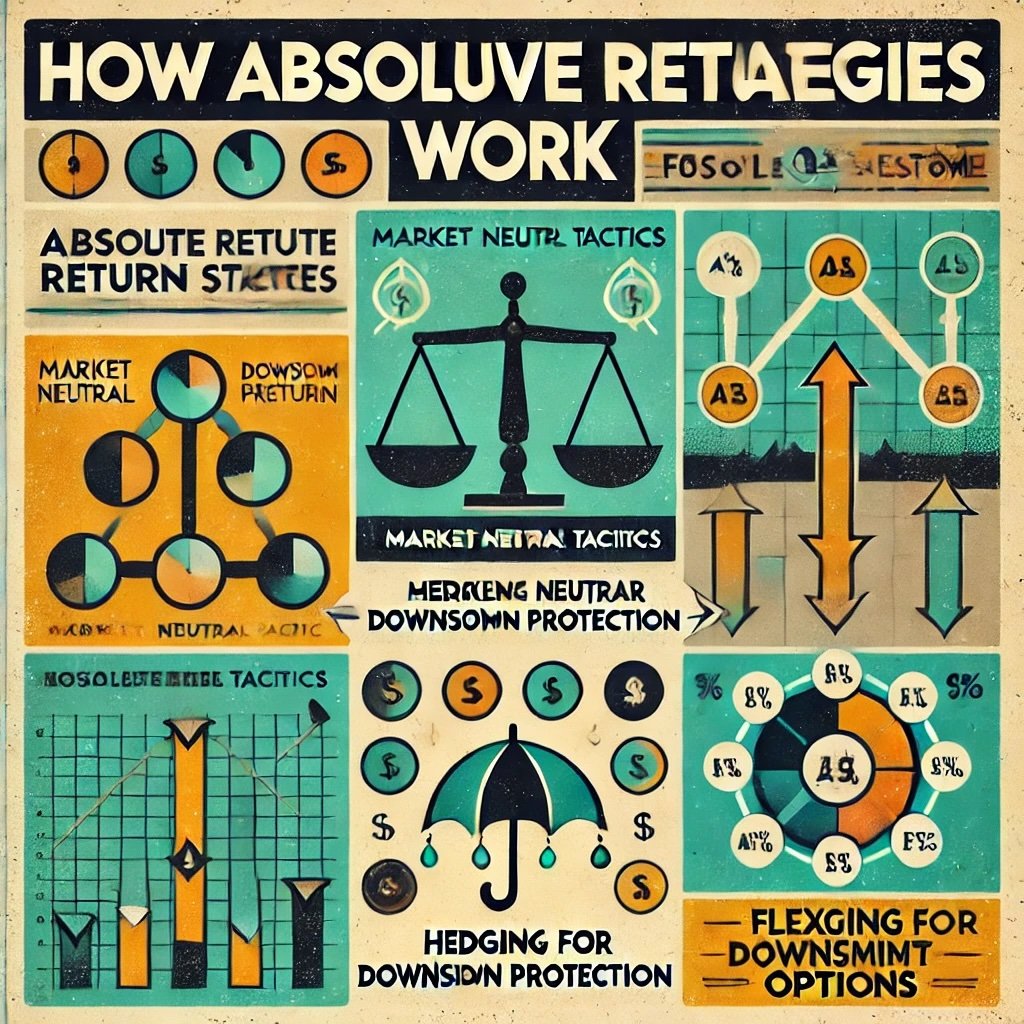
How Absolute Return Strategies Work
When traditional investments ride the market’s ups and downs, absolute return strategies aim for steady, positive results, regardless of the economic climate. These approaches aren’t about chasing benchmarks or mirroring the S&P 500. Instead, they’re focused on delivering returns through diverse, flexible strategies designed to perform in a variety of conditions. Let’s dive into how these strategies achieve their goals and the types of investments that embody them.
Key Characteristics of Absolute Return Strategies
Absolute return strategies are unique in their focus on minimizing correlation with the broader market. Instead of moving in lockstep with traditional assets, they aim for reduced correlation, offering stability when other investments may be fluctuating. This makes them especially valuable in times of economic uncertainty or downturns.
Some of the core characteristics include:
- Consistent, Positive Returns: The primary goal of absolute return strategies is to produce positive results over time, regardless of market direction. While no strategy guarantees profits, these approaches use advanced techniques to improve the odds.
- Flexibility in Strategy: Absolute return strategies employ a wide range of tactics, including long/short positions, arbitrage, and hedging. By using these techniques, they can navigate both up and down markets. For instance, a long/short equity strategy involves buying undervalued stocks (going long) while shorting overvalued ones, enabling gains from both price increases and declines.
- Risk Management: Absolute return managers place a strong emphasis on risk control. Through active hedging and diversification across asset classes, these strategies aim to protect against significant losses and offer a smoother performance curve.
Common Types of Absolute Return Investments
The term “absolute return” encompasses various investment vehicles and strategies, each with a unique approach to achieving consistent, positive returns. Here’s a look at some of the main types and how they work:
1. Hedge Funds
Hedge funds are perhaps the most well-known type of absolute return investment. These funds utilize a wide array of strategies to generate returns, including leveraging long/short equity, arbitrage, and macroeconomic plays. Hedge fund managers are known for their flexibility, employing techniques that adapt to market conditions and target positive returns in any environment.
- Example: A hedge fund manager might take a long position in a stable industry, like utilities, while shorting a more volatile one, such as technology, during times of economic stress. This balance aims to protect gains while mitigating losses.
2. Market-Neutral Funds
Market-neutral funds aim to balance long and short positions so that their net exposure to the broader market is close to zero. By neutralizing market exposure, these funds reduce the impact of broader market movements and instead focus on delivering returns based on individual stock performance.
- Example: A market-neutral fund might go long on high-performing pharmaceutical companies and short underperforming ones in the same sector. This approach aims to capture gains based on stock selection rather than sector-wide trends.
3. Managed Futures
Managed futures funds invest in a variety of futures contracts across asset classes, including commodities, currencies, and interest rates. They can go long or short on these contracts, enabling profits from both rising and falling markets. Managed futures often employ trend-following strategies, capitalizing on the price momentum of various assets.
- Example: During a commodity boom, a managed futures fund might take a long position on oil futures. Conversely, if a downturn is expected, they may short the same futures, aiming for profits as prices fall.
How These Strategies Reduce Market Dependency
The reduced reliance on market trends is one of the key appeals of absolute return strategies. Because they’re designed to perform independently of overall market movements, these investments add a layer of protection during market downturns. Traditional portfolios tied heavily to stock and bond performance can experience significant volatility in uncertain economic times. Absolute return investments, with their distinct focus on individual asset performance and non-correlated strategies, help balance this volatility.
Techniques for Success in Absolute Return Strategies
Absolute return managers rely on several core techniques to optimize performance:
- Arbitrage: This strategy involves taking advantage of price differences between related assets. For instance, in merger arbitrage, an investor might buy the stock of a company being acquired and short the acquiring company’s stock, profiting from the difference as the merger completes.
- Long/Short Equity: By holding both long and short positions in equities, managers can hedge against general market movements and profit from specific stock performance.
- Hedging: Hedging techniques, such as options and futures, help protect portfolios from downside risk, ensuring smoother returns over time.
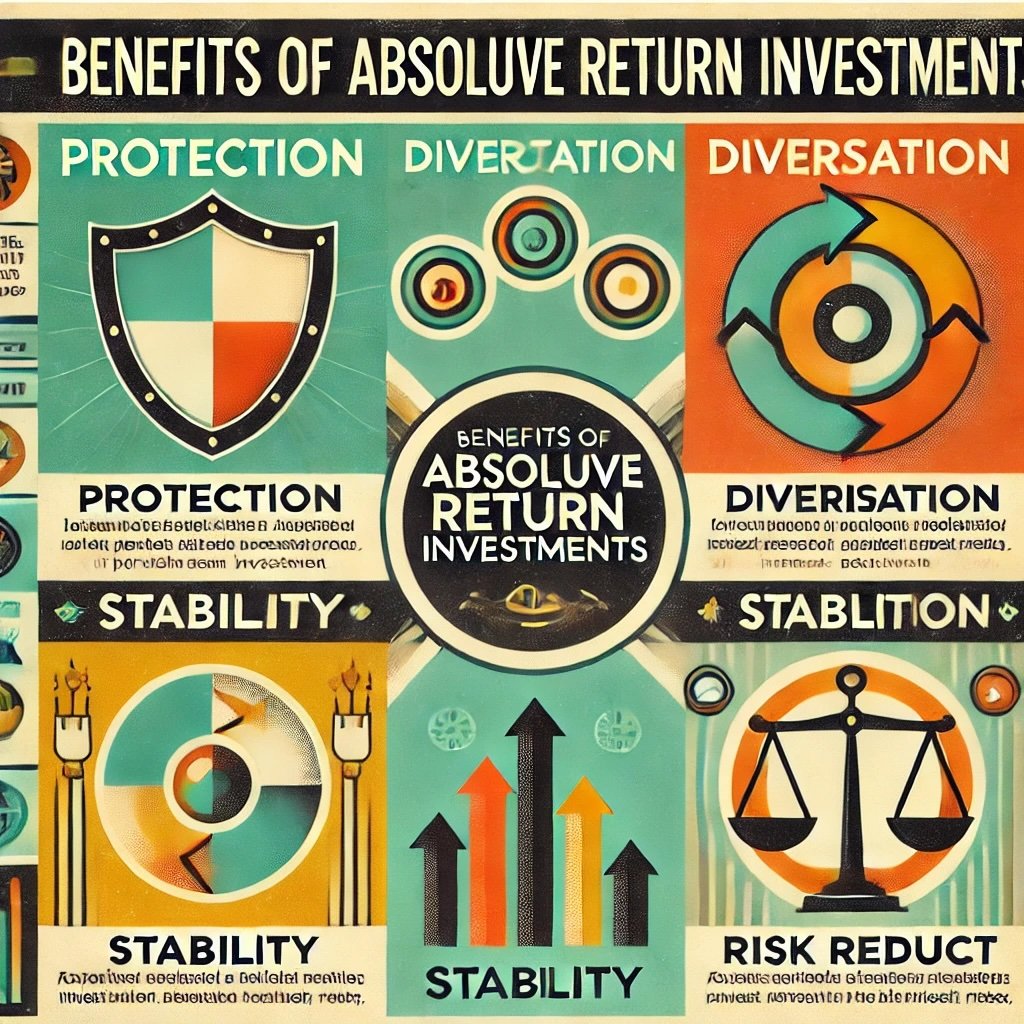
Benefits of Absolute Return Investments
Investors often look for ways to protect their portfolios, especially in unpredictable or down-trending markets. Absolute return investments offer a solution designed not to follow the crowd but to create consistent, positive returns, no matter the market conditions. By doing so, these strategies help diversify portfolios, add stability, and reduce overall risk. Let’s explore how absolute return investments bring these advantages.
Diversification and Low Market Correlation
A standout feature of absolute return investments is their low correlation with traditional markets, such as equities and bonds. This means they don’t depend on the ups and downs of the stock market to perform well. Instead, they generate returns based on their unique strategies, whether markets are soaring or slumping.
- Independent Returns: Absolute return investments are designed to seek positive returns regardless of whether markets are up or down. They often employ strategies like long/short equity, arbitrage, and macro-trend following to achieve gains that are independent of general market trends.
- Enhanced Portfolio Diversification: Adding absolute return strategies to a portfolio that contains stocks and bonds enhances diversification, creating a buffer against market volatility. When traditional assets face downturns, absolute return investments may continue performing well, helping to balance losses.
For example, during the 2008 financial crisis, many hedge funds utilizing absolute return strategies managed to protect or even grow investor capital, offering valuable resilience in a highly volatile period. This low correlation with broader markets makes absolute return strategies particularly useful during times of economic uncertainty.
Risk Management and Reduced Volatility
Another significant advantage of absolute return investments is their focus on risk management. Unlike traditional assets that can suffer considerable swings in volatile markets, absolute return strategies are designed to minimize these fluctuations, aiming for more consistent and stable returns.
- Limiting Downside Risk: Absolute return strategies prioritize protection against large losses. They employ techniques like hedging and diversification across asset classes to limit exposure to sharp downturns. For example, a market-neutral fund might balance long positions in one stock with short positions in another to keep overall exposure neutral. This approach reduces the impact of any one investment or market movement on the portfolio as a whole.
- Stabilizing Returns: Because absolute return strategies aim for positive returns in all conditions, they’re generally less prone to the large ups and downs that characterize the stock market. Investors in absolute return funds can often expect smoother performance and lower volatility over time. This stability can be particularly appealing to those who want to avoid the stomach-churning dips that sometimes come with stock investments.
By maintaining a focus on positive returns and downside protection, absolute return strategies reduce the need for investors to worry about day-to-day market swings. This allows investors to stay invested over the long term, benefiting from the gradual growth of their portfolios without frequent adjustments.
How Absolute Return Strategies Contribute to Stability
Investors looking to create a stable portfolio can benefit from the structure and objectives of absolute return strategies. Here’s a look at a few ways these investments help contribute to long-term portfolio stability:
- Income Generation: Many absolute return investments provide regular income, as well as capital appreciation. For example, managed futures may offer returns through both short-term gains and consistent income, adding a predictable cash flow element that can help stabilize a portfolio’s overall performance.
- Adaptability to Changing Markets: Absolute return strategies are often more flexible than traditional assets, able to adjust tactics based on shifting conditions. If markets show signs of recession, these strategies may adjust positions to minimize exposure or even take advantage of the downturn, providing peace of mind for investors in volatile periods.

The Unique Value of Reduced Volatility
Low volatility is often seen as a mark of stability, making absolute return investments ideal for risk-conscious investors. In absolute return investing, lower volatility is achieved through careful risk management, diversification, and tactical decision-making.
For instance, arbitrage strategies in absolute return funds focus on capturing small, predictable gains rather than swinging for large, risky profits. By limiting exposure to large, sudden losses, these strategies provide peace of mind, helping investors focus on long-term goals without the constant stress of unpredictable price movements.
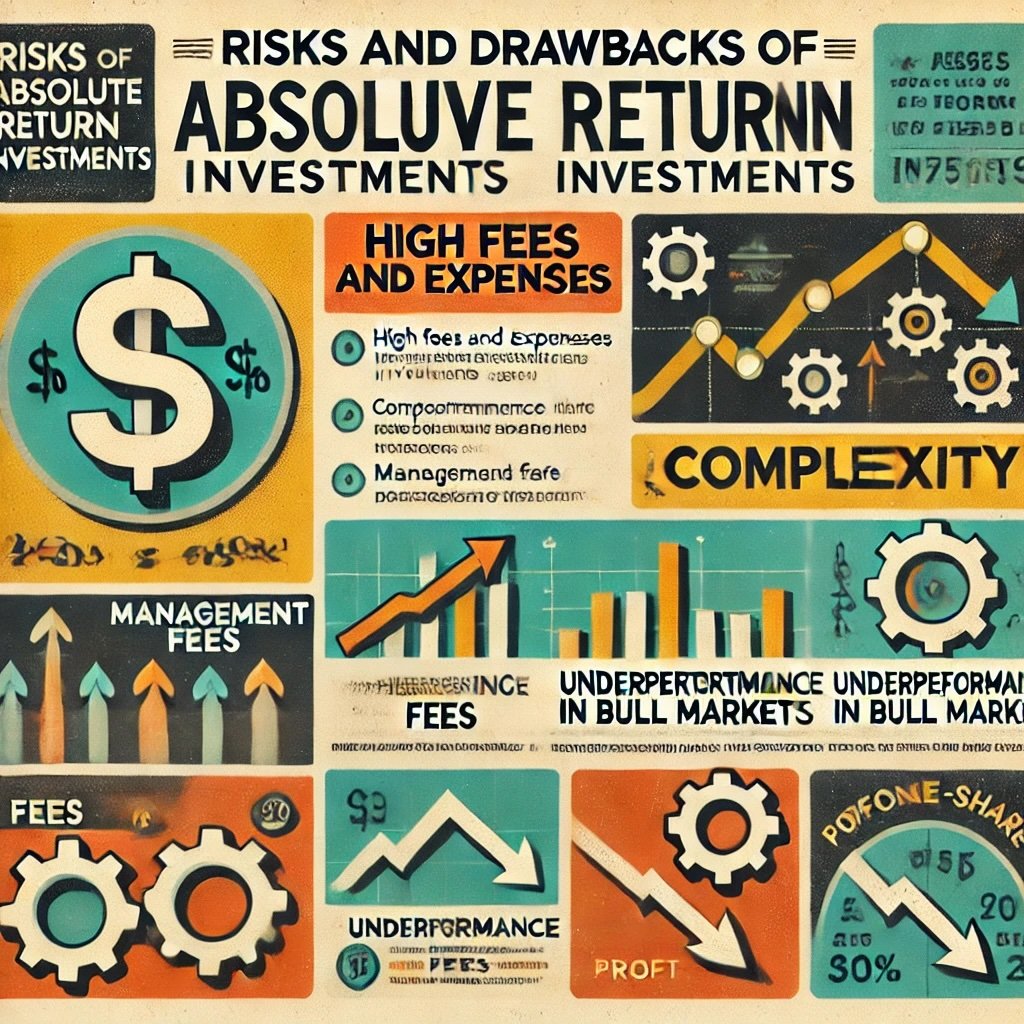
Risks and Drawbacks of Absolute Return Investments
While absolute return investments offer the allure of positive returns regardless of market direction, they aren’t without their own challenges. Understanding the potential risks, such as high fees, complexity, and underperformance during bull markets, is crucial for investors. Let’s explore the key drawbacks and considerations of absolute return strategies so you can decide if they’re right for you.
High Fees and Expenses
One of the most prominent downsides to absolute return investments is their fee structure. Unlike traditional investment vehicles, which often charge a straightforward annual management fee, absolute return funds frequently come with management fees plus performance-based fees.
- Management Fees: These fees cover the ongoing costs of managing the fund and are typically a percentage of assets under management (AUM). It’s not uncommon for hedge funds or other absolute return vehicles to charge a 1-2% management fee.
- Performance Fees: On top of management fees, absolute return funds often include performance fees. This is a percentage of profits generated by the fund, commonly around 20%. These fees are designed to incentivize managers to produce high returns but can significantly reduce the net gains for investors.
For instance, if a hedge fund charges a 2% management fee and a 20% performance fee, and it achieves a 10% return in one year, the investor may ultimately see only 6% after fees. By contrast, traditional mutual funds often have lower fees, typically around 0.5% to 1.5%, and lack the performance fees found in absolute return strategies.
In short, the high fee structure can erode returns over time, making it essential for investors to carefully evaluate whether the performance justifies the cost.
Complexity and Transparency Issues
Absolute return strategies are often sophisticated, involving techniques like arbitrage, derivatives, and short selling. While these strategies can enhance returns and provide diversification, they also make the investments complex and harder to understand for the average investor.
- Complexity: Strategies like merger arbitrage, statistical arbitrage, and long/short equity require specialized knowledge. They demand that investors understand not only the specific tactics employed but also the inherent risks associated with these approaches. Without a solid grasp of these methods, it can be difficult to accurately assess potential outcomes.
- Transparency Challenges: Certain absolute return vehicles, such as hedge funds, may lack transparency. Hedge funds, in particular, are not required to disclose detailed holdings or strategies, leaving investors with limited insight into the fund’s activities. This opacity makes it difficult to understand the exact risks, especially if the fund employs highly leveraged or high-risk strategies.
For many investors, this lack of transparency can feel unsettling, especially when combined with high fees and complex strategies. Before diving into absolute return funds, it’s essential to consider whether you’re comfortable with less information about where your money is being allocated.
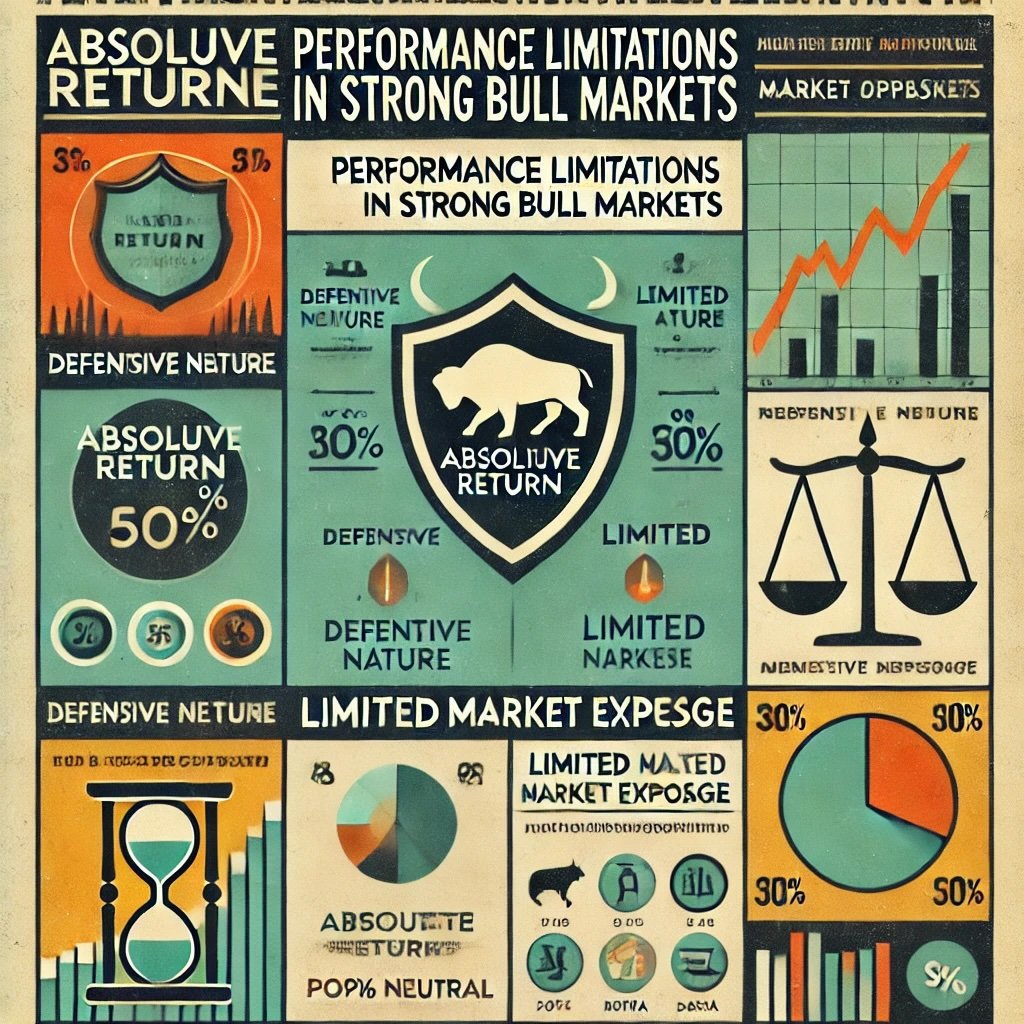
Performance Limitations in Strong Bull Markets
While absolute return investments aim to deliver positive returns regardless of market conditions, they may fall short in strong bull markets. This is because they’re often structured to protect against downside risk rather than to capitalize on market rallies. Here’s how that works:
- Defensive Nature: Absolute return funds typically prioritize risk management and diversification, which can mean holding positions that hedge against potential downturns. For example, a market-neutral strategy balances long and short positions to reduce exposure to general market movements. In a strong bull market, however, this balanced approach may lead to missed opportunities for higher gains.
- Limited Market Exposure: Many absolute return strategies, especially those focused on capital preservation, lack direct exposure to equities, which can be a disadvantage during significant market rallies. While traditional stock portfolios may see substantial growth during a bull run, absolute return funds may produce more modest returns due to their defensive positioning.
For instance, during periods like the post-2008 recovery or the 2020 market rally, many absolute return funds lagged behind the broader stock market. This is because they didn’t fully participate in the upside, choosing instead to maintain a cautious, market-neutral stance. For investors who prefer aggressive growth in strong markets, this conservative approach may feel limiting.
Summary of Key Drawbacks
Absolute return investments come with specific risks and challenges that set them apart from traditional investment vehicles. Here’s a quick summary of the main drawbacks to keep in mind:
- High Fees: Management and performance fees can reduce net returns, making it essential to assess if the fund’s returns justify the costs.
- Complexity: Strategies are often complex and may require advanced knowledge to fully understand, which can be intimidating for less experienced investors.
- Transparency: Limited disclosure in some funds, like hedge funds, can make it difficult for investors to monitor or evaluate the specific investments within the fund.
- Underperformance in Bull Markets: Due to their defensive structure, absolute return funds may underperform during strong market rallies, offering steadier returns at the expense of growth potential.
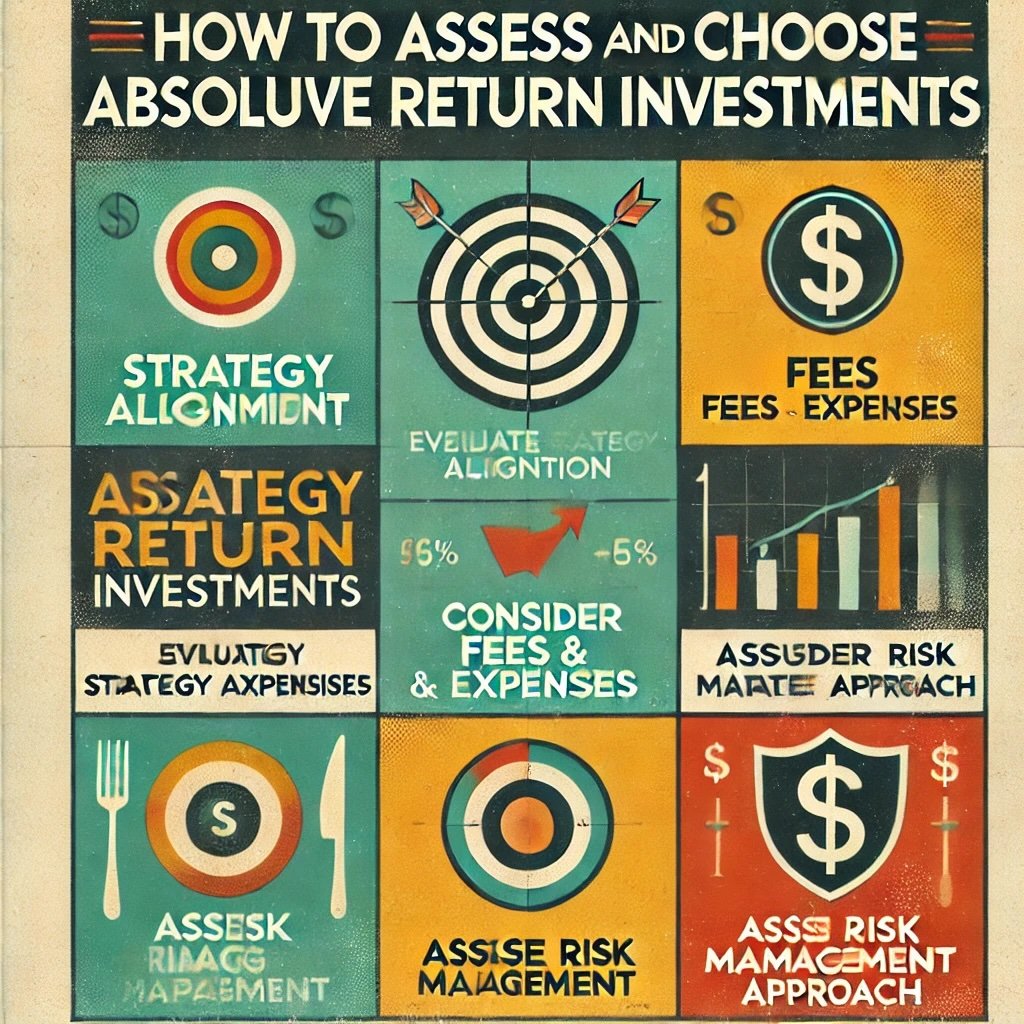
How to Assess and Choose Absolute Return Investments
Selecting the right absolute return investments for your portfolio involves assessing risk, evaluating performance metrics, and aligning choices with your personal investment goals. This section breaks down essential metrics and factors to consider, helping you make informed choices that align with your financial objectives.
Key Metrics for Evaluation
Evaluating absolute return investments requires looking beyond standard performance figures like annualized returns. Instead, risk-adjusted metrics give a clearer view of how well an investment might perform while managing downside risk.
Sharpe Ratio
The Sharpe Ratio is a commonly used metric in evaluating risk-adjusted performance. It measures the return of an investment relative to its risk, with higher values indicating better risk-adjusted returns.
- Calculation: The Sharpe Ratio is calculated by subtracting the risk-free rate (often based on Treasury bills) from the investment’s return and dividing the result by its standard deviation (a measure of volatility).
- Relevance: A high Sharpe Ratio suggests that the investment offers a good balance of risk and reward, while a low ratio indicates it might not be worth the risk taken.
In absolute return investments, where the aim is steady, positive returns regardless of market direction, the Sharpe Ratio helps highlight funds that generate consistent gains with lower volatility.
Sortino Ratio
While similar to the Sharpe Ratio, the Sortino Ratio focuses specifically on downside risk. It excludes positive returns from the risk calculation, giving a more nuanced look at how well the investment manages losses.
- Calculation: The Sortino Ratio is calculated by subtracting the risk-free rate from the investment’s return and dividing by the downside deviation (volatility of only the negative returns).
- Relevance: In strategies that prioritize capital preservation, such as many absolute return funds, the Sortino Ratio can be an excellent indicator. A high Sortino Ratio shows the investment has a solid performance relative to the downside risk, which is crucial in volatile markets.
Maximum Drawdown
Another critical metric is Maximum Drawdown, which measures the largest peak-to-trough decline over a specific period.
- Calculation: Maximum Drawdown is calculated as the percentage decline from an investment’s peak value to its lowest point over a specific timeframe.
- Relevance: Maximum Drawdown gives insight into the potential losses an investor might experience, which is especially useful in absolute return strategies aiming to minimize drawdowns. Investments with lower maximum drawdowns are typically more stable, making this metric valuable for those seeking steady returns.
Together, these metrics provide a rounded view of an absolute return fund’s ability to generate positive returns while controlling for volatility and downside risk.
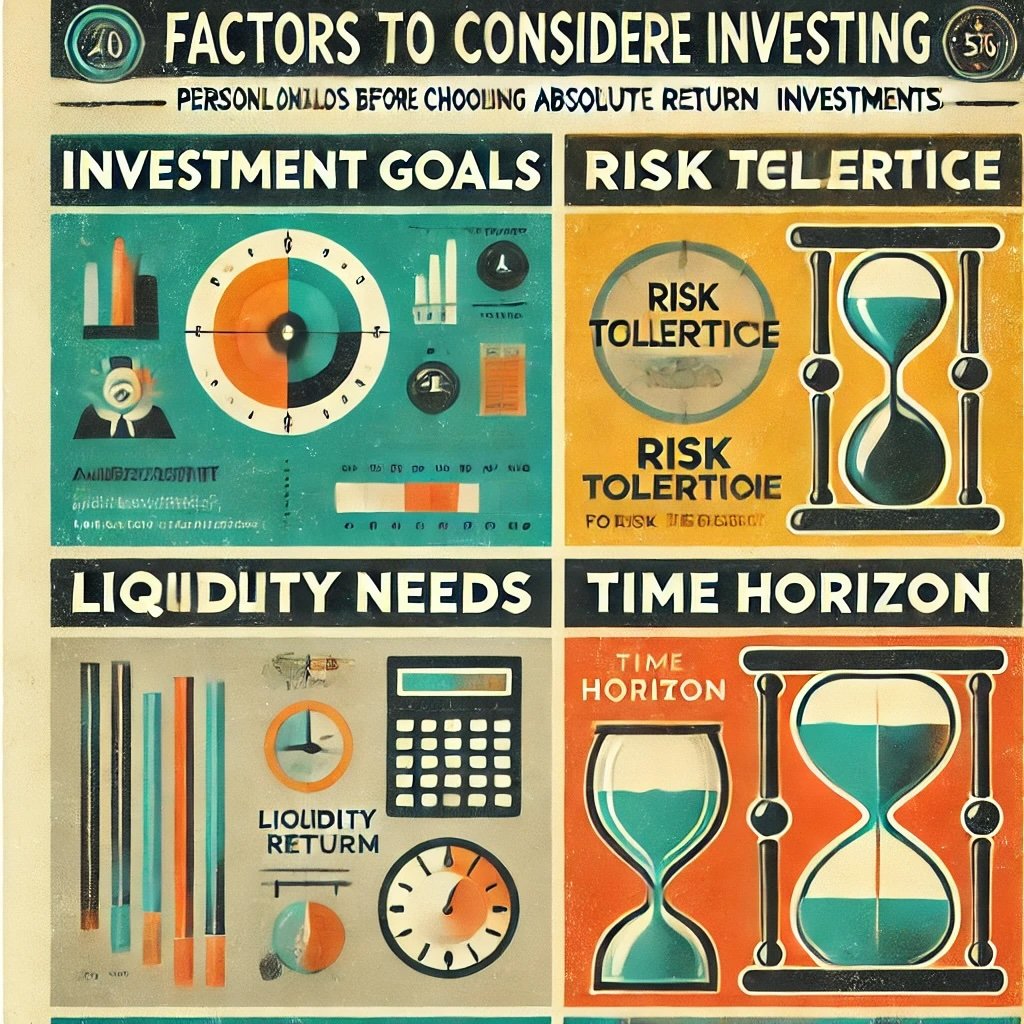
Factors to Consider Before Investing
Beyond the metrics, understanding your own investment needs and goals is critical. Each absolute return strategy has unique characteristics that may or may not align with your objectives. Let’s look at some personal factors to consider before investing in these funds.
Investment Goals
Clarifying your investment goals helps determine if absolute return strategies are suitable for your portfolio. If your primary aim is steady returns and downside protection, absolute return investments could be a good fit. These funds often focus on capital preservation and risk management, which can be ideal for conservative or long-term investors.
On the other hand, if you’re seeking aggressive growth or maximum gains during bull markets, absolute return strategies may fall short due to their defensive nature. Understanding your goals will guide you toward strategies that complement your broader financial plan.
Risk Tolerance
Absolute return investments appeal to those with a low to moderate risk tolerance. These strategies are designed to protect against significant losses, making them attractive for risk-averse investors or those nearing retirement who want to safeguard capital.
However, some absolute return strategies, such as leveraged hedge funds, can introduce more complexity and risk, which may not align with a conservative risk profile. It’s essential to match the specific strategy’s risk level with your comfort level and financial situation.
Liquidity Needs
Consider how accessible your investment capital needs to be. Liquidity refers to how easily you can convert an asset into cash without affecting its value. Absolute return vehicles like hedge funds often have limited liquidity, requiring a lock-up period where funds are inaccessible for a set time.
For investors with immediate or short-term cash needs, high-liquidity absolute return options like market-neutral mutual funds may be more suitable. Understanding liquidity constraints helps prevent unexpected cash flow issues.
Time Horizon
Time horizon is another factor that influences the suitability of absolute return investments. These strategies are typically best suited for medium- to long-term horizons, as their steady returns accumulate over time. Short-term investors might find that the fees and limited upside potential do not align with their goals, whereas long-term investors may benefit from the gradual capital preservation and stability.
Key Takeaways for Choosing Absolute Return Investments
Choosing the right absolute return investment means combining performance metrics with a clear understanding of your financial needs. Here’s a quick recap of the key factors to keep in mind:
- Metrics for Evaluation: Look for a strong Sharpe or Sortino Ratio and a low Maximum Drawdown to gauge risk-adjusted returns and downside protection.
- Personal Investment Goals: Absolute return investments work best for those seeking steady gains rather than high-risk growth.
- Risk Tolerance: Ensure the strategy’s risk profile matches your comfort level with potential losses and market exposure.
- Liquidity Needs: Choose an investment with the right balance of liquidity for your cash flow requirements.
- Time Horizon: Absolute return strategies favor long-term investors who prioritize capital preservation and gradual growth.
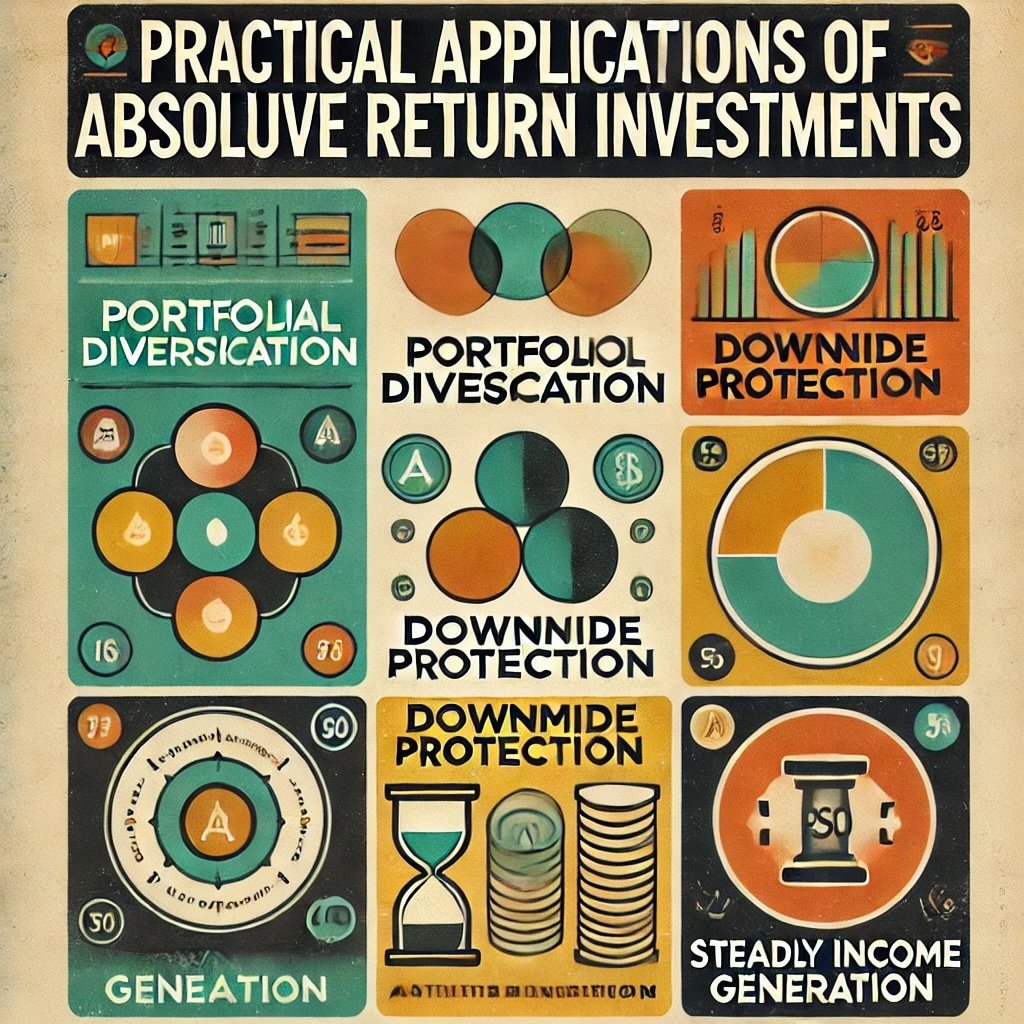
Absolute Return Investments, Explained: 12-Question FAQ (With Practical, No-Jargon Answers)
What exactly are “absolute return” investments?
Absolute return strategies aim for positive returns across market environments—up, down, or sideways—rather than beating a benchmark like the S&P 500. They use flexible toolkits (long/short, hedging, arbitrage, derivatives) to pursue results that are less dependent on broad market direction.
How are they different from traditional “relative return” funds?
Relative return strategies are graded against an index; being “down less than the market” can still count as success. Absolute return focuses on the dollar outcome: striving to make money irrespective of whether a benchmark rises or falls.
What types of strategies fall under “absolute return”?
Common sleeves include market-neutral equity, long/short equity, managed futures (trend), global macro, merger/stat arb, convertible arb, and multi-strategy blends. Many combine several to diversify sources of return.
Why might I add them to a portfolio?
Three big reasons:
Diversification (often low/negative correlation to stocks and bonds),
Drawdown control (tools to hedge and go short), and
Return smoothing (aiming to cut volatility so you can stay invested).
What are the main trade-offs or risks?
They can lag in strong bull markets, may be whipsawed in choppy tapes, often carry higher fees, and vary widely by manager (process, leverage, risk). Manager selection matters.
How much allocation is typical?
Rules of thumb: 5–10% for diversification, 10–20% if you want meaningful drawdown mitigation. Size according to your risk tolerance, liquidity needs, and patience with tracking-error versus a stock/bond mix.
Which vehicles can I use (and how liquid are they)?
ETFs/’40-Act/UCITS funds: daily liquidity, transparent, generally lower cost.
Hedge funds/Limited partnerships/Managed accounts: broader tactics, potential performance fees, lockups/gates may apply.
Match the vehicle to your liquidity and fee preferences.
How do I evaluate an absolute return fund?
Look beyond headline returns to risk-adjusted and path metrics: Sharpe, Sortino, MAR, max drawdown, volatility, beta to equities/bonds, correlation in stress, hit rate, time to recovery, and capacity/fees. Process clarity and risk governance are critical.
How do they behave in bull vs. bear markets (and inflation/rates)?
Bull: may trail pure equities but can still contribute from non-equity trends.
Bear: potential crisis diversification if shorts/hedges and trend signals engage.
Inflation/rising rates: strategies with commodities/FX/rates breadth (e.g., managed futures, macro) can find opportunities outside stocks/bonds.
What about taxes?
Vehicles using derivatives can generate short-term gains; treatment varies by jurisdiction. Consider tax-advantaged accounts where possible, and compare after-fee, after-tax expectations. ETFs may be more tax-efficient than LPs.
What due-diligence questions should I ask?
What edge and time horizon does the strategy target?
How are risk limits, leverage, and position sizing set?
In which markets does it trade; how diversified?
What were the worst periods, and what did the team change after?
Fees, capacity, team tenure, ops/controls, transparency/reporting.
How do I implement and maintain the sleeve?
Fund in tranches (to reduce timing luck), set a target weight with rebalance bands, review quarterly for process discipline (not just returns), and keep expectations realistic: crisis diversifiers shine over full cycles, not every quarter.
Practical Applications of Absolute Return Investments
Absolute return investments offer a unique opportunity to strengthen portfolio stability. These investments are designed to provide positive returns regardless of market conditions, making them an appealing option for investors seeking steady performance. In this section, we’ll look at how absolute return investments can be effectively used in portfolio construction, and we’ll discuss some final considerations for their integration.
Using Absolute Returns for Portfolio Stability
Absolute return investments can serve as a stabilizing force, especially during volatile market periods. Unlike traditional investments tied to the broader market, absolute return strategies aim for positive outcomes in all market environments, which can help mitigate overall portfolio volatility.
Incorporating Absolute Return Investments into Asset Allocations
Here’s how absolute return strategies might fit into different portfolio models:
- Conservative Portfolio: For conservative investors focused on protecting capital, absolute return investments can occupy a substantial portion of the portfolio—perhaps around 20-30%. Including strategies like market-neutral funds or certain hedge funds, these investments add a layer of risk management while maintaining the potential for modest returns.
- Balanced Portfolio: In a balanced portfolio, which typically has a mix of equities and bonds, absolute return investments can represent around 10-15%. This allocation provides diversification beyond stocks and bonds, helping balance growth potential with a focus on preserving capital.
- Aggressive Portfolio: For aggressive portfolios where growth is the primary objective, absolute return investments can play a defensive role, comprising 5-10% of the allocation. Here, they act as a hedge against market downturns, adding stability without overshadowing the portfolio’s growth orientation.
By positioning absolute return investments according to the risk tolerance and goals of each portfolio type, investors can enhance resilience and manage downside risk.
Examples of Absolute Return Strategies in Action
Absolute return investments often employ strategies designed to capitalize on specific market events or price inefficiencies, independent of market direction. Here are a few examples:
- Long/Short Equity: This strategy takes long positions in undervalued stocks and short positions in overvalued ones. When incorporated into a diversified portfolio, it offers the potential for gains regardless of overall market trends.
- Market-Neutral Funds: Market-neutral strategies aim to balance long and short positions so that the portfolio’s exposure to market direction is minimized. These funds seek profits based on individual stock performance rather than overall market movements, making them ideal for reducing correlation with traditional equity investments.
- Managed Futures: Managed futures utilize derivatives to capitalize on price trends in various asset classes, including commodities, currencies, and fixed income. Since managed futures are often uncorrelated with stocks, they can diversify a portfolio and perform well in both inflationary and deflationary environments.
Final Considerations and Key Takeaways
Absolute return investments have specific characteristics that make them well-suited for some investors but not for everyone. Before incorporating these investments into a portfolio, it’s essential to weigh their advantages, understand potential risks, and consider how they align with your broader strategy.
Key Benefits of Absolute Return Investments
- Low Correlation with Traditional Assets: Absolute return strategies often have little correlation with traditional asset classes like equities and bonds, adding diversification and resilience to portfolios.
- Consistent, Positive Returns: Unlike traditional investments that may struggle in a bear market, absolute return investments aim to generate steady returns, regardless of market direction.
- Risk Management: With an emphasis on hedging and tactical management, absolute return strategies are structured to minimize losses, providing peace of mind during volatile periods.
These benefits can be particularly valuable in portfolios where preserving capital and managing risk are priorities. However, it’s essential to consider that absolute return strategies are not a one-size-fits-all solution.
Important Drawbacks to Consider
Despite their advantages, absolute return investments come with certain drawbacks:
- Higher Fees: Many absolute return funds, especially hedge funds, have higher fees compared to traditional funds. Management and performance fees can reduce overall returns, so weighing these costs against potential benefits is crucial.
- Complexity and Transparency: Absolute return strategies, such as those used by hedge funds, can be complex and less transparent than conventional funds. Investors should be comfortable with this complexity and seek transparency wherever possible.
- Potential Underperformance in Bull Markets: Absolute return strategies may not capture the full upside during strong market rallies, as they focus on stable returns rather than maximizing growth. For growth-focused investors, this defensive stance might feel restrictive.
Understanding both the benefits and limitations of absolute return investments will allow you to make informed decisions about their role in your portfolio.
Consulting a Financial Advisor for Personalized Guidance
For those considering absolute return investments, consulting a financial advisor can provide valuable insights tailored to your unique situation. An advisor can help you assess:
- Risk Tolerance and Investment Goals: Ensuring that absolute return investments align with your financial goals and comfort level with risk.
- Optimal Allocation: Determining the appropriate allocation of absolute return investments within your broader portfolio, whether in a conservative, balanced, or aggressive model.
- Strategy Selection: Choosing the right mix of absolute return strategies, such as long/short equity or market-neutral funds, to enhance your portfolio’s stability and resilience.
With professional guidance, investors can confidently integrate absolute return investments, knowing they’re enhancing portfolio performance while managing risks.
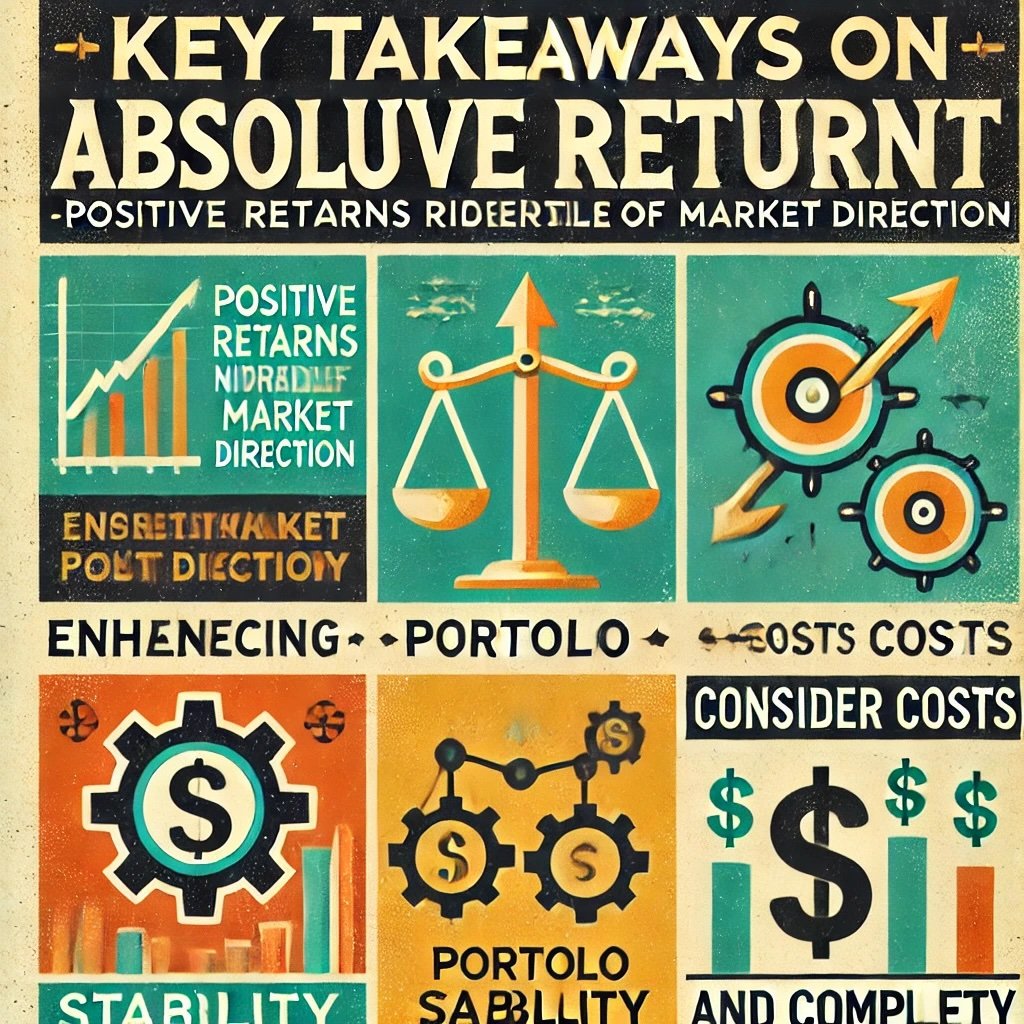
Key Takeaways
To wrap up, here are the main points to remember about absolute return investments and their potential applications:
- Positive Returns Regardless of Market Direction: Absolute return investments aim for stable gains across different market environments, which can be particularly valuable for risk-averse investors.
- Enhancing Portfolio Stability: By including absolute return strategies, investors can reduce volatility and achieve a better balance between growth and capital preservation.
- Consider Costs and Complexity: Be mindful of fees and the complexity of some strategies, ensuring they’re a good fit for your investment knowledge and preferences.
Absolute return investments offer unique advantages that can support long-term portfolio goals, especially when stability is a priority. When thoughtfully integrated, they provide a powerful tool to strengthen portfolios and improve resilience across diverse market conditions.
Important Information
Comprehensive Investment Disclaimer:
All content provided on this website (including but not limited to portfolio ideas, fund analyses, investment strategies, commentary on market conditions, and discussions regarding leverage) is strictly for educational, informational, and illustrative purposes only. The information does not constitute financial, investment, tax, accounting, or legal advice. Opinions, strategies, and ideas presented herein represent personal perspectives, are based on independent research and publicly available information, and do not necessarily reflect the views or official positions of any third-party organizations, institutions, or affiliates.
Investing in financial markets inherently carries substantial risks, including but not limited to market volatility, economic uncertainties, geopolitical developments, and liquidity risks. You must be fully aware that there is always the potential for partial or total loss of your principal investment. Additionally, the use of leverage or leveraged financial products significantly increases risk exposure by amplifying both potential gains and potential losses, and thus is not appropriate or advisable for all investors. Using leverage may result in losing more than your initial invested capital, incurring margin calls, experiencing substantial interest costs, or suffering severe financial distress.
Past performance indicators, including historical data, backtesting results, and hypothetical scenarios, should never be viewed as guarantees or reliable predictions of future performance. Any examples provided are purely hypothetical and intended only for illustration purposes. Performance benchmarks, such as market indexes mentioned on this site, are theoretical and are not directly investable. While diligent efforts are made to provide accurate and current information, “Picture Perfect Portfolios” does not warrant, represent, or guarantee the accuracy, completeness, or timeliness of any information provided. Errors, inaccuracies, or outdated information may exist.
Users of this website are strongly encouraged to independently verify all information, conduct comprehensive research and due diligence, and engage with qualified financial, investment, tax, or legal professionals before making any investment or financial decisions. The responsibility for making informed investment decisions rests entirely with the individual. “Picture Perfect Portfolios” explicitly disclaims all liability for any direct, indirect, incidental, special, consequential, or other losses or damages incurred, financial or otherwise, arising out of reliance upon, or use of, any content or information presented on this website.
By accessing, reading, and utilizing the content on this website, you expressly acknowledge, understand, accept, and agree to abide by these terms and conditions. Please consult the full and detailed disclaimer available elsewhere on this website for further clarification and additional important disclosures. Read the complete disclaimer here.





